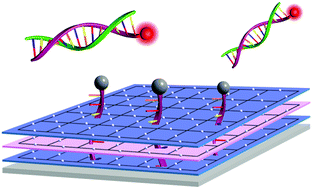The effect of pore size and layer number of metal–porphyrin coordination nanosheets on sensing DNA†
Abstract
Metal–organic framework (MOF) nanosheets are a new type of two-dimensional nanomaterial. Their properties and performances are expected to correlate strongly with the sheet structure, particularly the number of layers (sheet thickness). Yet, synthetically controlling the layer number at the molecular scale is highly difficult. Herein, a facile method is introduced to fabricate substrate-supported MOF nanosheets with precisely controllable layer numbers, using the Langmuir–Blodgett technique. Large-area, porous, and uniform MOF nanosheets, based on 5,10,15,20-tetrakis[4′-(terpyridinyl)phenyl]porphyrin-cobalt(II) (Co-TTPP) coordination polymer, were constructed and characterized in detail by atomic force microscopy, transmission electron microscopy, energy dispersive spectroscopy, powder X-ray diffraction, X-ray photoelectron spectroscopy, and a photoelectronic conversion technique. As a prototype sensor device, a series of substrate-supported Co-TTPP nanosheets was further investigated for the fluorescence detection of DNA towards rapid clinical diagnosis. The ten-layer Co-TTPP nanosheet exhibits an impressive performance with a very low detection limit of ca. 0.1 nM, outstanding specificity, and multiplexed DNA detection, comparable to some top-notch free-standing nanomaterial sensors. Importantly, our results also revealed the synergistic contributions of suitable pore size and optimal layer number of the Co-TTPP nanosheet for highly efficient DNA detection for the first time.



 Please wait while we load your content...
Please wait while we load your content...